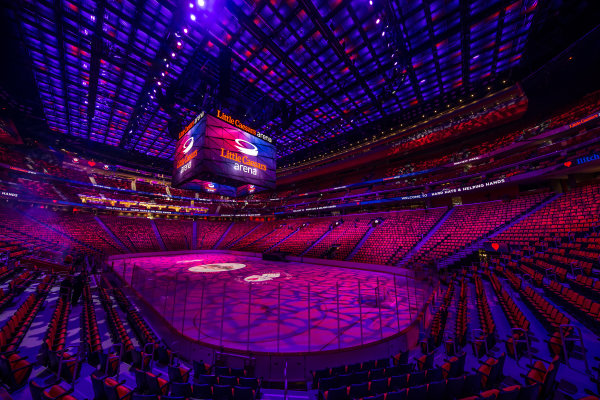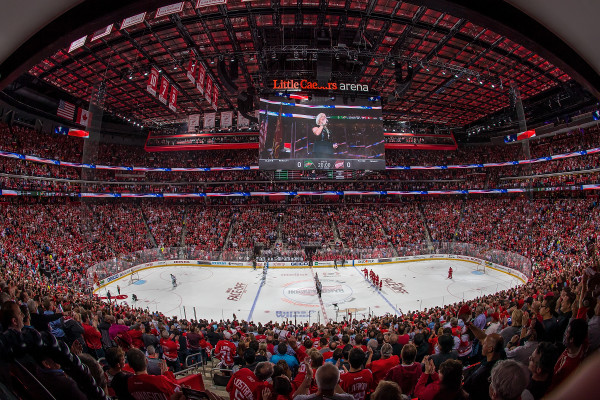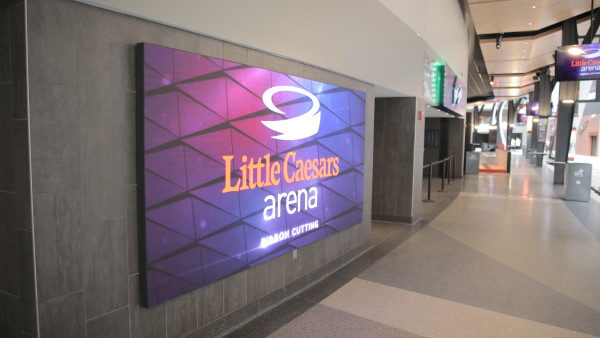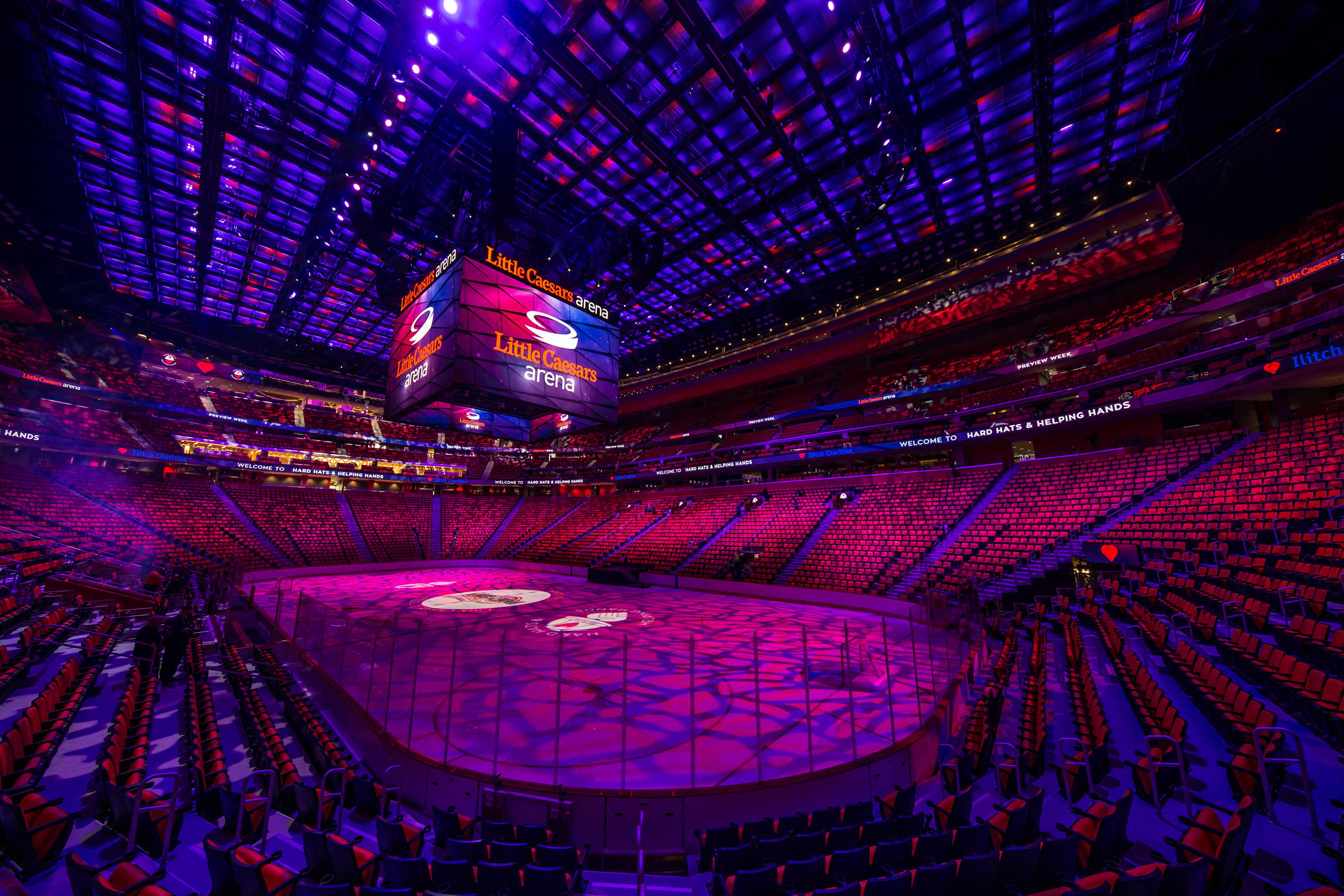Anyone who still thinks Detroit is down and out doesn’t really know the score.

The District Detroit, encompassing a 50-block area in the heart of the city, is one of the largest sports and entertainment developments in the country. Led by the Ilitch organization, its newest addition is Little Caesars Arena, a stunning, 20,000-seat successor to Joe Louis Arena, and home to the Detroit Red Wings and Detroit Pistons. Joining the nearby Comerica Park and Ford Field, District Detroit features the highest density of professional sports teams in any of the nation’s downtown cores.
Replete with a JBL audio system and spectacular video displays designed, manufactured, and installed by Daktronics, and a concourse area offering fans unique experiences from AV integrator, Bluewater, Little Caesars Arena expands the notion of what it means to claim “state-of-the-art” status.
“In addition to Bluewater and Daktronics, we worked with various agencies including the large scale format company, Infinite Scale,” said Craig Turnbull, senior vice president, marketing and communications, Olympia Entertainment and Detroit Red Wings. “They developed our logo, created a full wayfinding system, worked on our concession stands and templates, and finalized work on the total consumer experience and finished design work.”
Olympia’s full, in-house production and creative teams were led by Pete Skorich and Bryan Durren, respectively. “Content was developed in-house, and we leaned heavily on Cisco Vision for Sports and Entertainment (formerly Cisco StadiumVision),” Turnbull noted. “There were a lot of players in this mix, and that creates challenges, but we had an amazing team approach. We’re all learning this together and will be able to update continually; that’s the great thing about digital technology.”
Fans attending concerts, shows, or sporting events at the new Little Caesars Arena will experience the largest seamless centerhung system in the world, with the new Daktronics scoreboard allowing video programming to completely wrap around the system and create a 360-degree experience. A total of 45 LED displays featuring more than 13,500 square feet and more than 16.5 million individual LEDs have been installed in and around the new arena.
Each side of the centerhung system, which connects seamlessly at the corners, measures approximately 28 feet high by 43.5 feet wide. Using a 6-millimeter pixel pitch, the displays bring high resolution images to fans at every event. The system features variable content zoning, allowing each side to show one large image or to be divided into multiple sections to show any variety of live video, instant replay, game statistics and information, animations and graphics, and sponsorship messages.

The main videoboard also features four under-mount displays to appeal to fans sitting closer to the action. Each display will measure more than 7 feet high by 9.5 feet wide and feature a 6-millimeter pixel pitch to show complementary content to the main displays. Together, the centerhung display will feature approximately 11 million individual LEDs, more than one for each person in Michigan.
Two ribbon displays circle the seating areas in the arena. Each features a 15-millimeter pixel pitch and measures 2.5 feet high. The upper ribbon measures 1,066 feet long and the lower ribbon measures 915 feet long. Additionally, 15 ribbon displays are installed throughout the arena’s seating bowl to provide additional content and the opportunity to highlight sponsors throughout events.
Seven exterior displays, including a 900-square-foot Chevrolet Plaza display, welcome fans and event goers as they enter the arena. Scorer’s tables and basket stanchion displays for basketball games, as well as dasher displays for hockey games are included with the installation.
The Daktronics system features the company’s Show Control System, combining display control software, video processing, data integration, and playback hardware.
“In today’s world, centerhung video displays add to the game-day excitement as facilities continually go bigger to attract fans and combat the at-home experience,” said Daktronics vice president of live events, Jay Parker. “Little Caesars Arena went big. They wanted their venue to be as exciting for fans and spectators as possible to keep them entertained throughout events. Every team has their own brand and image, and the centerhung for Little Caesars Arena matches the image of their home teams and who they are as sports franchises. We’re continually trying to help our customers find something unique in terms of their video displays and something that reinforces their brand.”
On The Concourse
Systems design and installation for the arena concourse was not the first rodeo for Bluewater, said Nick Marino, director of sales, integration, at the firm. “We’ve worked with Olympia Entertainment in the past and have a great relationship with them. In 2016, we worked on their Preview Center which was used to show off the District Detroit project and bring in potential suite holders and patrons.”

There, Bluewater used a 3D printed image of the District and Little Caesars Arena, utilizing projection mapping technology, to demonstrate what suite holders would experience. The top of a scale model was “cut off” using advanced projection mapping techniques and arena sports games were projected onto their playing surface. In another space, a demo of an actual suite was set up in which potential patrons could experience a suite’s arena view from a large-format video screen, approximately a 165-inch image.
Bluewater then was asked to focus on the arena’s concourse, providing brand activations and interactive features to highlight offerings from several sponsors such as Comerica. The install includes 10 LED walls, Pistons and Red Wings headless mannequin photo opportunities, and three kiosks for other sponsors. Framed artwork in the Players Club—an intimate, exclusive section where fans can watch players up close on their way between the arena and the locker room—was done with large, custom prints repeated on the club’s entrance doors and walls.
Other areas of installation included the Comerica LED arch, the Huntington Bank’s entrance customized archway, and a Belfor Property Restoration interactive story wall. The story wall was installed with two 55-inch interactive displays in a 1x2 format with a touch overlay to create interactivity.
In the Heritage Room on the second floor, a 1.9-millimeter pixel pitch LED provides a clear picture for videos of old championships, past games, and award ceremonies. ‘We also installed a Crestron Control System and Harman/JBL audio for voice amplification and program audio for presentations and rentals to sponsors and other organizations,” Marino said.
Perhaps nothing imbues the sentimental feel of the arena more than Sandy, a small, motorized horse wrapped by Bluewater with the Pistons and Red Wings logos. “The horse represents Meijer (grocery, electronics chain) and is extremely nostalgic to many patrons and employees at Meijer,” Marino noted.
The LED displays for the project are from Absen. “We’ve used them extensively for their great design, value, and quality,” he said. “Our subject matter expert, Doug Wack, speaks Mandarin and has an established relationship with Chinese manufacturers. He understands that world and its tech and helps us from the consultative perspective and with size, pricing, and vendor management.”
The installed LEDs range in size from about 6 feet square to 6 feet by 26 feet, and from 1.6-to 4-millimeter pixel pitch. “Chris Ilitch, (son of the late Mike Ilitch), originally considered a large video cluster but then consulted with us,” Marino explained. “We recommended that he look at LED and LCD side by side, and after that comparison, it was LED throughout.”
Bluewater used a range of pixel pitches to meet the requirements of each application and provide the best possible value. “For screens with a very close viewing distance, we specified tighter pixel pitch, and for screens that say, hung high up on a wall behind a bar, we offered a bit lower resolution. Each location was tailored to provide the right viewing experience for that location and set of parameters.”
Bluewater’s partners on the project included Motor City Electric Technologies, who were a part of the onsite install, as well general contractor Barton Malow-Hunt-White. Bluewater’s in-house team included programmers, design engineers, and others, including Jessica Koessler, Woody Booth, Dave Bauman, Ken Box, Derek Monette, Andrea Hlavaty, Brian Sieloff, Jim Gould, and the Bluewater Studio team.
“We worked on this design/build with the owner, Olympia Entertainment’s lead team, Craig Turnbull, and Molly Wurdack-Folt, as well as the owner’s rep and with project executive Steve Chrusciel, of the Chrusciel Group,” Marino said. “We started on the Concourse design in January 2017, got the go-ahead in April, and completed the install the weekend before Labor Day.
“This time frame was the biggest challenge in terms of working around the other trades, but everyone did a great job of completing it in time for the scheduled ribbon cutting. The arena opened with concerts from Kid Rock and the venue was well received. This venue is on par with many of the newer arenas, but it’s ahead with the amount of LED installations where some others have video walls. Our LEDs ensure that the brands are exposed and prominent.”
The Game’s Not Over
At District Detroit, the beat goes on. Olympia Development of Michigan (the Ilitches’ real estate company), working as owners or in partnership, will develop six residential and retail areas including some 686 apartments in The District Detroit.
“We’ve also recently leased unique office spaces to Google; 100 of their employees will be able to look out over our concourse, Turnbull said. “After all, this is a sports town with more than 200 nights of events a year. Until five or six years ago you couldn’t even see a crane here. Now, many companies want to be a part of what’s going on.”
And the arena is a big part of that enthusiasm. “You can’t build just an arena anymore; we’ve done this project in a big way,” Turnbull said. “When the owners, the Ilitch family, decided that the development would be here, in downtown Detroit, rather than in the suburbs, that vision became a part of the glue that has kept this city together. This middle area, connecting the corporate downtown center with midtown’s universities, hospitals, and residential hubs for young people, represents a much needed spark. The arena is that spark, encouraging and engaging others to develop and invest here.”
Karen Mitchell is a freelance writer based in Boulder, CO.
